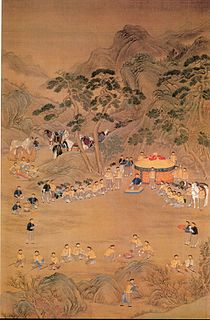
The Qing dynasty, officially the Great Qing, was the last imperial dynasty of China. It was established in 1636, and ruled China proper from 1644 to 1912. It was preceded by the Ming dynasty and succeeded by the Republic of China. The multiethnic Qing empire lasted for almost three centuries and formed the territorial base for modern China. It was the fourth largest empire in world history in terms of territorial size.

Dorgon, formally known as Prince Rui, was a Manchu prince and regent of the early Qing dynasty. Born in the Aisin Gioro clan as the 14th son of Nurhaci, Dorgon started his career in military campaigns against the Ming dynasty, Mongols and Koreans during the reign of his eighth brother, Hong Taiji, who succeeded their father.

The Kangxi Emperor, given name Xuanye, was the fourth Emperor of the Qing dynasty, and the second Qing emperor to rule over China proper.

The Shunzhi Emperor was the third Emperor of the Qing dynasty, and the first Qing emperor to rule over China proper, reigned from 1644 to 1661. A committee of Manchu princes chose him to succeed his father, Hong Taiji (1592–1643), in September 1643, when he was five years old. The princes also appointed two co-regents: Dorgon (1612–1650), the 14th son of the Qing dynasty's founder Nurhaci (1559–1626), and Jirgalang (1599–1655), one of Nurhaci's nephews, both of whom were members of the Qing imperial clan.

The Qianlong Emperor was the sixth Emperor of the Qing dynasty, and the fourth Qing emperor to rule over China proper, reigned from 1735 to 1796. Born Hongli, the fourth son of the Yongzheng Emperor, he reigned officially from 11 October 1735 to 8 February 1796. In 1796, he abdicated in favour of his son, the Jiaqing Emperor—a filial act in order not to reign longer than his grandfather, the Kangxi Emperor, who ruled for 61 years. Despite his retirement, however, he retained ultimate power as the Retired Emperor until his death in 1799; he thus was one of the longest-reigning de facto rulers in the history of the world, and dying at the age of 87, one of the longest-lived. As a capable and cultured ruler inheriting a thriving empire, during his long reign the Qing Empire reached its most splendid and prosperous era, boasting a large population and economy. As a military leader, he led military campaigns expanding the dynastic territory to the largest extent by conquering and sometimes destroying Central Asian kingdoms. This turned around in his late years: the Qing empire began to decline with corruption and wastefulness in his court and a stagnating civil society.

The Yongzheng Emperor, born Yinzhen, was the fifth Emperor of the Qing dynasty, and the third Qing emperor to rule over China proper, reigned from 1722 to 1735. A hard-working ruler, the Yongzheng Emperor's main goal was to create an effective government at minimal expense. Like his father, the Kangxi Emperor, the Yongzheng Emperor used military force to preserve the dynasty's position.

The Southern Ming, officially the Great Ming, was a series of dynastic rump states ruled by the Zhu clan in southern China following the Ming dynasty's collapse in 1644. The Ming dynasty ended when Shun forces led by Li Zicheng captured Beijing and the last Ming emperor Chongzhen committed suicide. The Ming general Wu Sangui then opened the gates of the Shanhai Pass in the eastern section of the Great Wall to the multi-ethnic Qing banners, in hope of using them to annihilate the Shun forces. Ming loyalists fled to Nanjing, where they enthroned Zhu Yousong as the Hongguang Emperor, marking the start of the Southern Ming. The Nanjing regime lasted until 1645, when Qing forces captured Nanjing. Later, a series of pretenders held court in various southern Chinese cities.
A xunfu was an important imperial Chinese provincial office under both the Ming and Qing dynasties. However, the purview of the office under the two dynasties differed markedly. Under the Ming, the post originated around 1430 as a kind of inspector-general and ad hoc provincial-level administrator; such a xunfu is usually translated as a grand coordinator. However, after the Manchu conquest of China in the mid-17th century, xunfu became the title of a regular provincial governor overseeing civil administration.

The imperial hunt of the Qing dynasty was an annual rite of the emperors of China during the Qing dynasty (1636–1912). It was first organized in 1681 by the Kangxi Emperor at the imperial hunting grounds at Mulan (modern-day Weichang Manchu and Mongol Autonomous County, near what would become the summer residence of the Qing emperors at Chengde. Starting in 1683 the event was held annually at Mulan during the autumn, lasting up to a month. The Qing dynasty hunt was a synthesis of earlier Chinese and Inner Asian hunting traditions, particularly those of the Manchus and Mongols. The emperor himself participated in the hunt, along with thousands of soldiers, imperial family members, and government officials.

Tibet under Qing rule refers to the Qing dynasty's rule over Tibet from 1720 to 1912. Tibet was under Khoshut Khanate rule from 1642 to 1717, with the Khoshuts conquered by Dzungar Khanate in 1717, and the Dzungars subsequently expelled by Qing in 1720. The Qing emperors appointed resident commissioners known as Ambans to Tibet, most of them are ethnic Manchus, who reported to the Lifan Yuan, a Qing government body that oversaw the empire's frontier. Tibet under Qing rule retained a degree of political autonomy under the Dalai Lamas nonetheless.
Events from the year 1662 in China.
Events from the year 1672 in China.
Events from the year 1675 in China.
Events from the year 1677 in China.
Events from the year 1678 in China.
Events from the year 1686 in China.
Events from the year 1688 in China.
Events from the year 1691 in China.
Events from the year 1693 in China.









